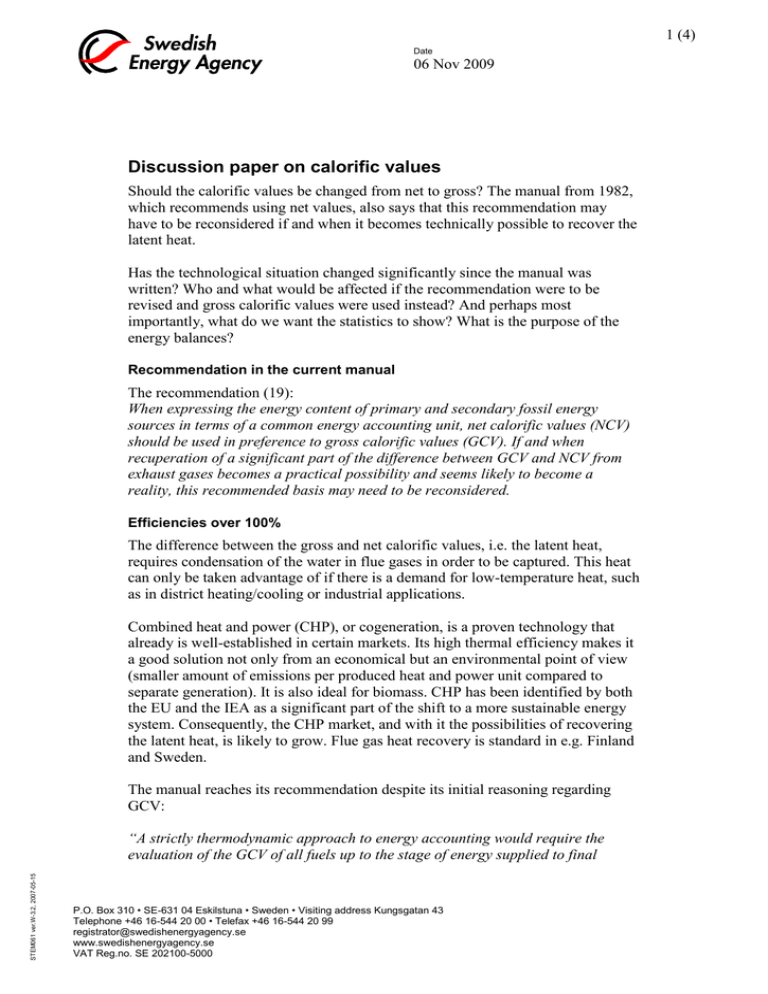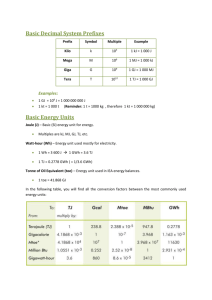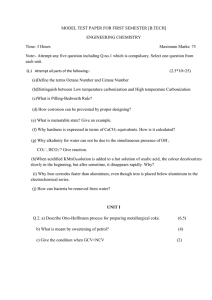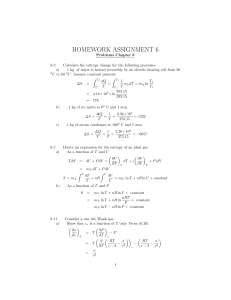Discussion paper on calorific values
advertisement

1 (4) Date 06 Nov 2009 Discussion paper on calorific values Should the calorific values be changed from net to gross? The manual from 1982, which recommends using net values, also says that this recommendation may have to be reconsidered if and when it becomes technically possible to recover the latent heat. Has the technological situation changed significantly since the manual was written? Who and what would be affected if the recommendation were to be revised and gross calorific values were used instead? And perhaps most importantly, what do we want the statistics to show? What is the purpose of the energy balances? Recommendation in the current manual The recommendation (19): When expressing the energy content of primary and secondary fossil energy sources in terms of a common energy accounting unit, net calorific values (NCV) should be used in preference to gross calorific values (GCV). If and when recuperation of a significant part of the difference between GCV and NCV from exhaust gases becomes a practical possibility and seems likely to become a reality, this recommended basis may need to be reconsidered. Efficiencies over 100% The difference between the gross and net calorific values, i.e. the latent heat, requires condensation of the water in flue gases in order to be captured. This heat can only be taken advantage of if there is a demand for low-temperature heat, such as in district heating/cooling or industrial applications. Combined heat and power (CHP), or cogeneration, is a proven technology that already is well-established in certain markets. Its high thermal efficiency makes it a good solution not only from an economical but an environmental point of view (smaller amount of emissions per produced heat and power unit compared to separate generation). It is also ideal for biomass. CHP has been identified by both the EU and the IEA as a significant part of the shift to a more sustainable energy system. Consequently, the CHP market, and with it the possibilities of recovering the latent heat, is likely to grow. Flue gas heat recovery is standard in e.g. Finland and Sweden. The manual reaches its recommendation despite its initial reasoning regarding GCV: STEM061 ver.W-3.2, 2007-05-15 “A strictly thermodynamic approach to energy accounting would require the evaluation of the GCV of all fuels up to the stage of energy supplied to final P.O. Box 310 • SE-631 04 Eskilstuna • Sweden • Visiting address Kungsgatan 43 Telephone +46 16-544 20 00 • Telefax +46 16-544 20 99 registrator@swedishenergyagency.se www.swedishenergyagency.se VAT Reg.no. SE 202100-5000 2 (4) Date 06 Nov 2009 energy users. With the interests of conservation data in mind, it has already been recommended that the amount of waste heat emitted to the atmosphere by power stations and other energy transformers should be explicitly shown in an energy balance. Logically it follows that in principle the GCV should be used as the basis for evaluating the energy content of fossil fuels.” The recommendation is based on a number of arguments: “At the practical level, however, an energy manager in a plant is not responsible for the loss of energy that he cannot access. Even though he must take delivery of the GCV in order to have access to the NCV […], he can only be held accountable for the use or misuse of the NCV.” Whether or not energy managers are responsible for the losses of their stations is irrelevant to the energy statistics. Besides, with the development of flue gas heat recovery one can argue that it is the managers’ choice not to use more efficient technologies. “Condensation of water will cause corrosion problems with SO2, and other residues and will call for more costly stainless or other corrosion-resistant materials.” Corrosion-resistant materials are used today in power stations with flue gas heat recovery. The technology has an added environmental benefit by cleaning the flue gases and collecting harmful substances in the condensate. “[The difference between GCV and NCV] is moreover a small part of the total amount of waste heat emitted to the atmosphere and for practical reasons only a part of this total heat loss can be recovered.” With differences of 10% for certain fuels this part may be a small part of the total heat loss, especially in an electricity only plant, but hardly negligible. With efficient flue gas heat recovery, one can actually obtain an overall efficiency of more than one hundred percent, which is unreasonable. Apart from being thermodynamically and logically impossible, the number is not informative if it is not known what “100%” refers to. Any plant that uses this technology will seem more efficient than it actually is if NCV is used (conventional plants too, in a sense). On the other hand, a plant without this possibility will seem less efficient if GCV is used. But when it comes to statistics one can hardly use two different calculation methods depending on the technology of the power plants, at least not if fuels are to be treated consistently. Using NCV to measure the efficiency of a conventional power plant may make sense because the latent heat cannot be utilised anyway. However, that (total) efficiency cannot be compared to the total efficiency of a CHP plant in which the latent heat is available. There is no point in showing efficiencies that are 3 (4) Date 06 Nov 2009 artificially high. On the contrary, this may make it seem as if there is no room for improvement. As a theoretical exercise, recalculation of district heat data for Sweden 2007 results in a 12% increase in fuel supply and a decreased efficiency, from 86% to about 76%, if gross calorific values are used instead of net. Is a change possible? What would the consequences of a change be? What are the calorific values used for? The Energy Statistics Manual (IEA/OECD/Eurostat) has the following explanation: “The calorific values are critical because they are used for several purposes: to create the energy balance, to calculate the estimate of CO2 emissions, and to check thermal efficiencies of inputs and outputs reported in the transformation sector.” According to the Energy Statistics Manual, “energy content of solid and liquid fossil fuels, and of renewables and wastes is expressed in net calorific value (NCV). Energy content of natural gas and manufactured gases is expressed in gross calorific value (GCV)”. For gases, these values are converted to NCV in the balance tables. In the IEA Annual Questionnaire both NCV and GCV are reported for coal, while renewables are reported in terms of NCV only. Additionally, classification of coals is done on a GCV basis. Calculations of emissions are based on calorific values. According to the IPCC Guidelines the reporting is done in net calorific values. The corresponding emission factors are, however, at least in some cases based on gross calorific values, which are then adjusted according to the Energy Statistics Manual (i.e. recalculated with a conversion factor). Regarding evaluation of set targets, such as emission limits or renewable quotas, the calculation method, including the calorific value, should be clearly defined in the legal text. This calls for a continued use and update of net values alongside the gross values if the net values are the basis for the calculations. Any legal consequences may need to be discussed further. Since conversion between the different values is done today with a simple factor, a change in the balances should not necessarily be difficult. Even if new gross calorific values were developed independent of the net values, conversion factors would be useful tools. Indeed, when recalculating historical data, conversion factors would probably be the only practical solution, at least for countries which have not previously collected GCV. Although, it should be noted that the use of conversion factors are by no means an exact method to obtain calorific values and should only be used as a complement when better data is unavailable. Apart from the administrative work for statisticians, would a change require much work? That depends on the extent to which the necessary data already is available. For example, the IEA presents the gas tables on a gross calorific value basis, but 4 (4) Date 06 Nov 2009 the balances on net calorific value basis. Do countries that use GCV, but naturally have to report values in NCV when this is required, solve this by using conversion factors or by keeping two sets of data? Comprehensive information to data suppliers, as well as in statistical publications, would in any case be necessary if the recommendation were revised. Conversely, if the practice of using net calorific values is kept, is there another way of accounting for the “extra” latent heat which currently is not included in the fuel supply data? Efficiency of fuel use The reasons for using NCV were mainly technological. This argument is no longer as convincing. The technology is available and power stations with the ability to apply it are likely to become more common. From a logical and technological point of view GCV should be used in reporting fuel data. However, a change may require an unreasonable amount of work and cause confusion. On the other hand, it appears that different standards already exist when expressing efficiencies of various technologies. This practice also differs between countries. Even though NCV might be preferable for certain technologies, using GCV is a way of showing the losses. If fuel is used in an electricity only plant, without the possibility of recuperating the latent heat, that fuel could have been used more efficiently elsewhere. Whether or not the latent heat theoretically can be taken advantage of in certain plants is beside the point. When NCV is used, not all losses to the atmosphere are accounted for. The net calorific values are shown in the energy balances today. If latent heat is taken advantage of in the transformation sector, this heat is not covered by the supply (the part of the fuel that provided the heat is not accounted for in the supply side). The efficiency of the transformation sector in the energy balances should perhaps be a measure of how efficiently the fuel is used rather than how well the power stations perform. Judging by the reasoning in the current manual the logical choice is to use GCV, but the question is whether making the recommendation more logical justifies the required additional work.


